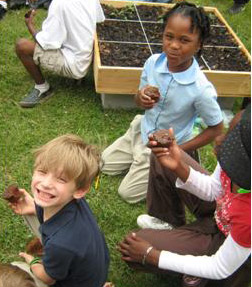By: Tracee Goodman
In order to best serve the increasing Brazilian population in the East Cobb School District in Marietta City Schools, it is imperative for the teachers in the elementary (k-5) schools of our district to have an understanding of this population’s culture, family dynamics, communication styles and how all of these aspects will effect them and the teacher in the educational environment. According to the U.S. Census, it is estimated that 35 thousand Brazilians are currently living in the state of Georgia, 60% o in Cobb County, followed by North Fulton with 20% of the population.
Because of the large number of Brazilians in the Cobb county school district, the ESOL lead teachers and I have discussed the obstacles and challenges that they have noticed in many of the elementary schools. The first of which is the language barrier. The national language of Brazil is Portuguese; many of the younger children (Kindergarten and First Grade) enter school speaking little or no English. It is imperative that these students are offered classes such as ESOL and additional English classes to keep them on grade level. Early detection will ensure the students success later in their educational careers. It has been brought to my attention that students are being placed in Spanish speaking classes because the teachers do not know or understand what the students needs are. We have to take the time to speak with family members early to uncover what the students’ needs are. Additionally, it is important to understand the nonverbal communication styles of the Brazilian population. I have attached the following Video link with many of the commonly used nonverbal/hand gestures used when communicating. http://www.youtube.com/watch?v=YMo-GpnbfWA&feature=related Understanding kinesics will help to understand the students’ interactions with you-as the teacher and the classmates. It is culturally customary for the student to avoid eye contact with the teacher as a show of respect. A typical greeting among peers is a kiss on each cheek. Contrary to American culture, Brazilians do not emphasize personal space. It is common in their culture to stand less than one foot away when conversing, distancing ones self is offensive. One other issue that the educator may need to “work with” when teaching students of Brazilian heritage is in the area of Proxemics more specifically, speaking out of turn. My research shows that taking turns to speak is not the rule; Brazilians will interrupt a conversation and will speak concurrently as this is culturally accepted. This can be a distraction in a class room setting, however, the teacher has to redirect and correct without offending the student or their culture.
It has been my observation that the Brazilian family tend to be large and the extended family is quite close. Therefore, teachers should expect family participation and they should encourage family presence for field trips, school performances and ceremonies. Please make every effort to accommodate families when possible.
Because Brazilian ethnic make up includes Portuguese, African, German, Italian, Spanish, and Polish, as a teacher it would be ideal to include the student and their heritage into the lesson as is comfortable to that student. Much of the population is derived from marriage of Portuguese and African slaves. This diversity of racial background can make the student feel comfortable in some settings and uncomfortable in others. So, it is vital that the educator keep the lesson plans and teaching tools unbiased.
Additional points that need to be observed when teaching students, who are Brazilians, are their religious practices. The religion of nearly 80% of the population is Roman Catholic.
Many other beliefs have been incorporated into the Brazilian catholic belief system, such as Spiritism, Buddhism, Hinduism, Ayahuasca, and Judaism as well as religious syncretism, such as candomblé, umbanda, and macumba that mix Catholicism with African tribal religions. When planning holiday celebrations or activities, it is important not to offend. Make every effort to remain neutral in the planning and execution of these activities. Chronomics may be an issue that the teacher may have to deal with and emphasize the importance of time management and timeliness. In comparison to the American “time is money” way of thinking, Brazilians have a more relaxed attitude toward time and the management of time. Teachers may have to express the importance of time management and give guidance to students who do not observe the importance of managing time properly.
Finally, competence of cultures other than one’s own requires acquiring a corpus of cultural information and understanding that might affect how a teacher instructs and how a student learns. In the classroom, being culturally competent also involves an understanding of how cultures differ under the surface and how cultures react differently to like situations. Acquiring cultural competence is a continuing process. It is achieved only after many experiences and interactions in the classroom with parents and peers. However, the process can begin with the knowledge and understanding of basic cultural differences that teachers are likely to encounter in the culturally diverse classroom. Awareness of these differences will aid teachers in understanding the complexity of teaching diverse groups of students. Here in Georgia, more specifically in the Cobb County School district, there is so much cultural mixing; teachers now have the obligation to interact in a diverse class setting. They must become cross-culturally competent and understand the ways in which cultures differ and how these differences affect the ways in which their students behave and learn. Through studying the cultural backgrounds of their students, teachers can learn to avoid some of the problems that are presented each day. This understanding can result in a productive educational environment for the teacher and student.
Also see Intercultural principles: A closer look
Make our society a better place
What we need to teach our ESOL students about Nonverbal communication


